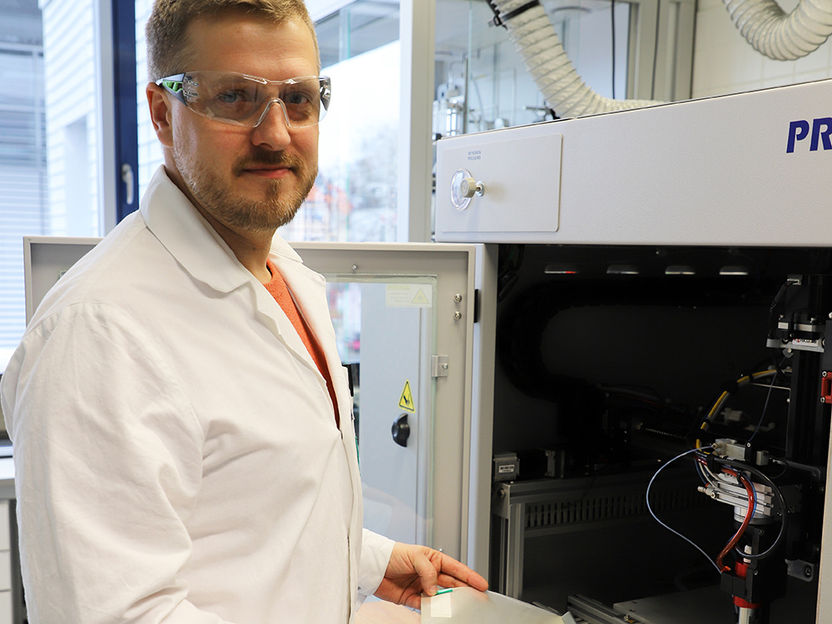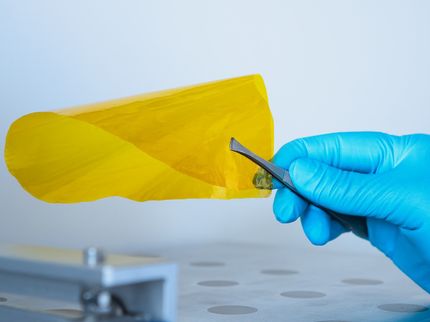Hydrogen Innovation: Project to scale AEM technology for industry applications
Fraunhofer IFAM and Sunfire, together with Canadian partners, are launching the "Integrate" research project
Advertisement
Research and industry have recognized the potential of alkaline AEM electrolysis and expect a fast technology development during the next decade. Fraunhofer IFAM and Sunfire, together with Canadian materials partner Ionomr Innovations, are now launching the "Integrate" research project to apply the promising technology on an industrial scale.

Clemens Kubeil prepares a membrane for coating at Fraunhofer IFAM’s electrolysis laboratory
Fraunhofer IFAM Dresden
To produce cost-effective green hydrogen, industry and energy companies need efficient electrolyzers on a large scale. Technologies such as pressurized alkaline or high-temperature electrolysis are already being installed in industrial environments. Another approach that shows great promise is the anion exchange membrane (AEM) technology.
AEM electrolysis combines the respective technical advantages of polymer exchange membrane electrolysis (PEM) and alkaline electrolysis (AEL). High power density, flexibility and high gas purity are qualities that AEM technology has in common with PEM technology. In addition, AEM technology is characterized by its cheap and non-critical materials – similar to AEL technology. Thus, AEM electrolysis has the potential to set new standards in the electrolysis market regarding both operating and investment costs.
Fraunhofer IFAM now also aims to validate these advantages within the “Integrate” project. Together with the electrolysis company Sunfire and the Canadian partners Ionomr Innovations, The National Research Council of Canada (NRC), the Simon Fraser University and the University of Alberta, the company is collaborating to develop an AEM electrolyzer in the upper double-digit kW range and to validate its technical feasibility under industrially relevant conditions for further scale-up.
At its Dresden site, Sunfire will provide a test stand with an electrolysis cell to measure the AEM stack’s performance. "With the 'Integrate' project, we are demonstrating our innovative strength and pioneering role in the globally growing electrolysis market," says Sunfire CTO Christian von Olshausen. "We are proud to partner with high-caliber technology and research partners and to strengthen our German Canadian collaboration."
Both Fraunhofer IFAM and Sunfire have many years of expertise in the field of electrolysis. While Sunfire as an electrolyzer manufacturer has its main competence in electrolysis technologies and system integration, Fraunhofer IFAM as a non-university institution focuses on applied research and the development and qualification of materials for alkaline stacks.
In the "Integrate" project, the institute designs and optimizes long-term stable, high-performance non-platinum groups of metal catalysts for use in dilute alkaline environments. In addition, porous transport layers (PTL) are optimized. Once promising catalysts and a PTL have been identified, Fraunhofer IFAM will produce electrodes that will be tested at Sunfire’s industrial test environment. Based on the results, the test rig will be modified accordingly to be operational for long-term AEM operation.
Clemens Kubeil, Research Assistant in the Hydrogen Technology Department responsible for the project at the institute, adds: "The production process at Fraunhofer IFAM will provide valuable experience in handling electrodes of the required size, so that no process has to be developed from scratch for upscaling on an industrial scale."
Ionomr Innovations’ CEO Bill Haberlin says: “Ionomr’s Aemion+® alkaline membranes being used in this application are durable, ultra-stable and maximize performance without the traditional expensive components for water electrolysis – like iridium, platinum, and titanium, replacing these with less expensive materials, such as those developed by Fraunhofer IFAM. Aemion® allows for longer lifetimes in highly basic environments, is developed with industrial applications in mind and available at commercial scale, and importantly, does not use perfluoro sulfonic acid (PFSA) materials that are becoming increasingly discontinued worldwide due to environmental concerns.”
Since October 1, 2022, the project has been funded by the German Federal Ministry of Education and Research (BMBF) for three years. Hergen Wolf, Director Product Management at Sunfire, emphasizes: "AEM technology is currently only available in the single-digit kW range and, therefore, cannot be used for large-scale hydrogen projects in industry. Together with our partners, we will create the conditions for transferring this promising technology from the laboratory to industrial application."
Other news from the department business & finance
Most read news
More news from our other portals
Something is happening in the chemical industry ...
This is what true pioneering spirit looks like: Plenty of innovative start-ups are bringing fresh ideas, lifeblood and entrepreneurial spirit to change tomorrow's world for the better. Immerse yourself in the world of these young companies and take the opportunity to get in touch with the founders.
























































